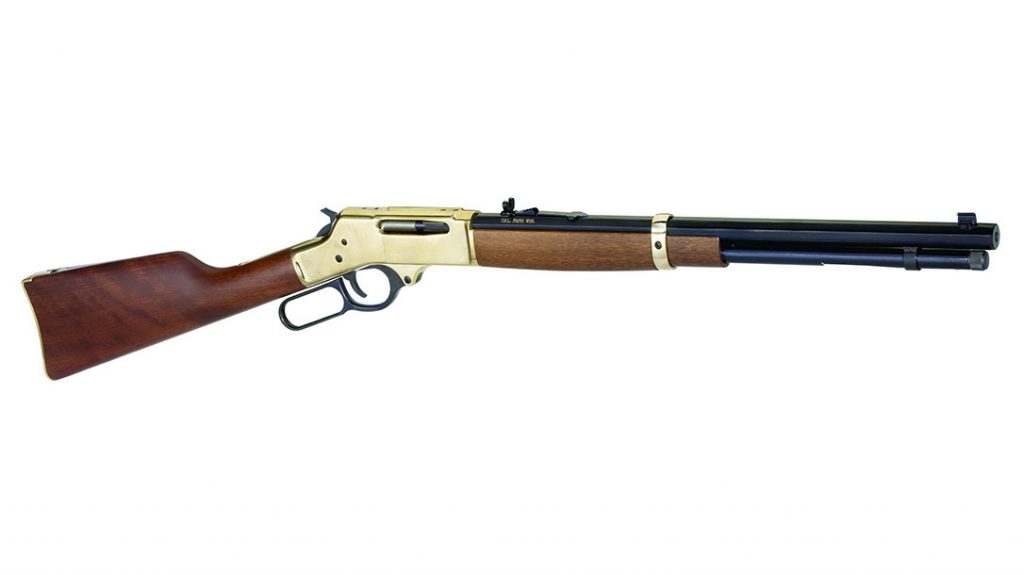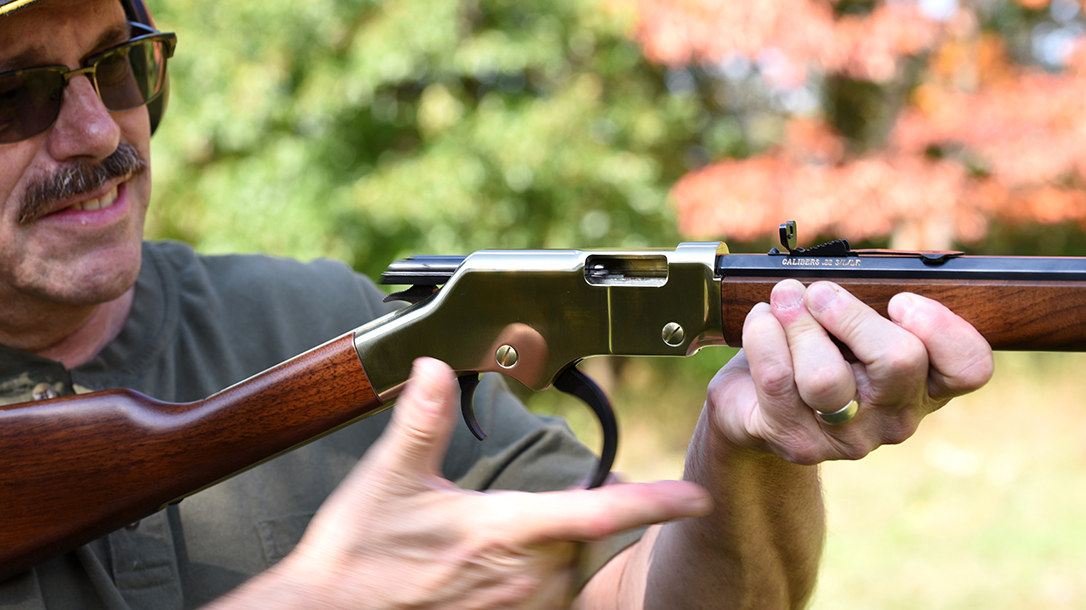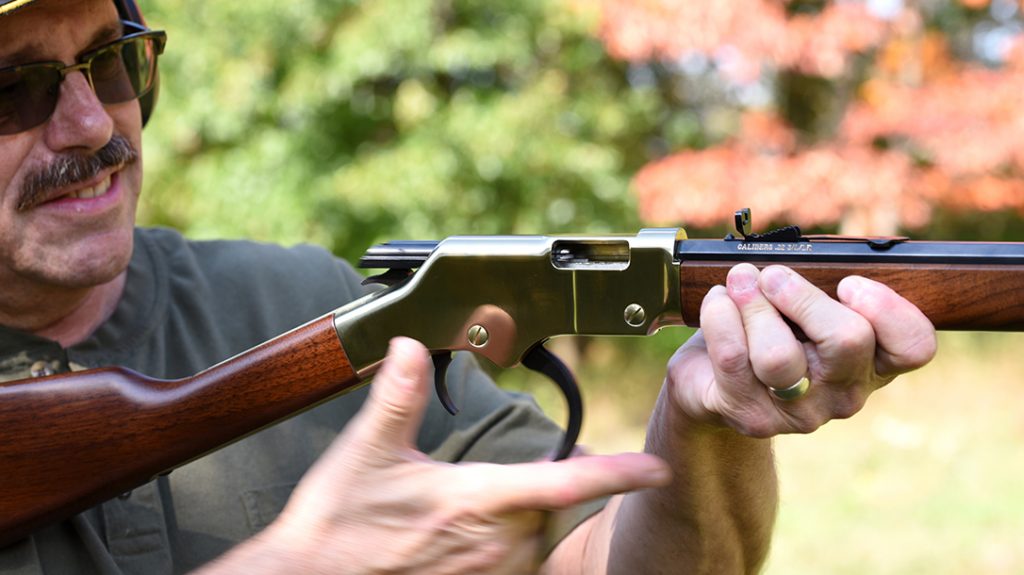Lever-Actions: The Game-Changer of The Civil War & Beyond
During the Atlanta campaign of 1864, a Confederate soldier told of his capture: “One of your men, in retreating [faced us four soldiers and fired] simultaneously with us. One of our group fell dead … The rest of us proceeded to load, when he fired twice in quick succession, killing two more of my comrades. At this point, I had my gun loaded and had a cap in my fingers [but] I dropped both … Sir, there is no use in the South fighting men armed as yours are armed.”
Union Captain Wilson of the 12th Kentucky Cavalry also found a repeating rifle helpful. One day as he sat at dinner with his family, seven Confederate guerillas burst in. He pleaded with them to “take me outside.” They consented. But at the door, Wilson raced for the corn crib and came up shooting. He killed five guerillas with five shots. The survivors ran for their horses, one losing fingers to a sixth bullet as he grabbed the saddle horn. Wilson dropped him with his seventh shot, the remaining man with his eighth.

Meet the Henry Rifle
Such was the South’s introduction to the Henry rifle. It had started at the New York workbench of inventor Walter Hunt. His “Volitional” repeater used external primers. Though unreliable, it had a novel tubular magazine and a cycling lever that would redefine hunting rifles forever. After Lewis Jennings, Horace Smith, and Daniel Wesson improved on Hunt’s design, Oliver Winchester bought what had become the Volcanic Arms Company and hired B. Tyler Henry to apply his talents. In 1860 Henry earned a patent for a 15-shot lever-action rifle in .44 rimfire. It was quirky, underpowered, and prone to leak gas. But, Winchester declared, “it can be fired fifteen times in ten seconds….”
Advertisement — Continue Reading Below
The Henry’s .44 rimfire round didn’t upend big animals. Its 216-grain bullet, pushed by 26 grains of blackpowder to 1,025 fps, packed less energy than does a 180-grain bullet in a short .357 handgun! The .30-30 hits harder at 350 yards than did the .44 Henry at the muzzle! Nelson King added a loading port to the Henry’s receiver. The resulting Model 1866 was the first rifle built by the Winchester Repeating Arms Company. It featured a lighter 200-grain .44 bullet and a stiffer 28-grain powder charge.
The Winchester Model 1873 that followed was an improved Model 1866. It chambered the .44-40 cartridge, Winchester’s first centerfire. A 40-grain charge launched a 200-grain bullet at 1,200 fps. In 1878 Colt offered its 1873 Single Action Army revolver in .44-40. Packing one type of ammo that worked in both a rifle and a revolver eliminated mix-ups. In a tight spot, you could load either gun. William F. Cody sent the following note from Nebraska in 1875. “For general hunting or Indian fighting I pronounce your improved Winchester [’73] the boss…” Bear hunting in the Black Hills, he wrote of stopping a charge: “Before he could reach me I had 11 bullets in him, which was a little more lead than he could comfortably digest…”
Carried by bandits and murderers, Texas Rangers and the RCMP, lever-action rifles in .44-40 rode in the scabbards of scouts and in the wagon boxes of sheepherders. It has been said that “The .44-40 has killed more people, good and bad, than any other commercial cartridge.” Given its long service in lawless environs, that’s a credible claim. The Winchester 1873 traveled widely abroad, serving homesteaders and military units in countries as yet untouched by civilization.
Advertisement — Continue Reading Below
The Lever-Action Evolves
The popular .44-40 had limited reach. For added pop, Winchester chambered the ’73’s long-action sequel—the Model 1876—to .45-75 WCF. The ’76 would be the last direct descendant of the Hunt repeater.
Meanwhile, a bright young gunsmith in Ogden, Utah, was designing a single-shot rifle. In 1883, Winchester salesman Andrew McAusland came across a used Browning. Impressed, he sent the gun to New Haven. Company vice president Thomas Bennett booked quick passage to Ogden. He found the Browning gun shop, billed as the biggest between Omaha and the Pacific, staffed by men barely out of their teens. But Bennett came to the point: “I want rights to your rifle.” John Browning said it was worth $10,000, a huge sum. Bennett countered at eight. The rifle later became Winchester’s Model 1885. Over the next 17 years, Browning would deliver 44 firearm designs to Winchester. Bennett bought them all. The first repeater, sold as the Model 1886, netted John Browning $50,000.
So delighted was Bennett with the 1886 that he asked Browning for an updated short-action rifle to replace the 1873. “I’ll pay $10,000 for a prototype in three months. Make it two months, and you’ll get $15,000.” John thought for a moment. “The price is $20,000 if I deliver in 30 days. If I’m late, it’s free.” Incredulous, Bennett agreed. Within two weeks, John and his brothers had built what would become the Winchester 1892, one of the most widely hailed lever guns ever. The Model 1894 that came next accepted longer cartridges, including the .30-30, our first smokeless centerfire hunting round.
Advertisement — Continue Reading Below
The 1895 was Winchester’s response to smokeless ammo with pointed bullets and high breech pressures. Announced in June 1896, the ’95 debuted in .30-40 Krag, .38-72-275, and .40-72-330. In 1898, the .303 British joined them, followed in 1903 by the .35 Winchester, and a year later by the .405. Theodore Roosevelt liked his .405; it “did admirably with lions, giraffes, elands” on safari. The .30 Government 03 was added in 1905, and the .30 Government 06 in 1908. The ’95 had a single-stack magazine, charged from the top. Around 5,000 early rifles had flat-sided receivers. Subsequent 1895s showed the more common sculpting.
If, after the Great War, you owned a lever-action rifle that wasn’t a Winchester, it was likely a Marlin. John Mahlon Marlin was 18 in 1853 when he apprenticed as a machinist in Connecticut. He agreed to take no wages for six months, after which he’d get $1.50—per week! Designing first pistols, then Ballard rifles, Marlin came up with the top-ejecting Model 1881 lever-action rifle in .40-60 and .45-70. It sold for $32. The subsequent 1889 spit emptied to the side and had a more reliable carrier. It followed the Model 1888, designed by L.L. Hepburn for the .32-20, .38-40, and .44-40. Hepburn’s 1893 took longer cartridges: the .32-40 and .38-55, then the .25-36, .30-30 and .32 Special. Marlin’s 93 soon sold like Winchester’s 94.
“A new gun especially for American big game” appeared in 1937. The Marlin 1936 cost $32. One year later, the 336 replaced it. The obvious difference was a round bolt “encased in the area of the locking bolt by a solid bridge of steel.” The Model 1895 has the same receiver but for .45-70-size cartridges.
Advertisement — Continue Reading Below
Enter the Hammerless Lever-Action
The last great lever-gun inventor of the 19th century, Arthur Savage, established a cattle ranch in Australia, ran a coffee plantation in Jamaica and designed a torpedo. In 1892, at age 35, he developed his hammerless repeating rifle. It was the first lever-action rifle with a coiled mainspring. The “Savage No. 1” had an eight-shot spool magazine. When in U.S. Ordnance trials, Savage’s rifle lost out to the Krag-Jorgensen bolt-action, he designed a trim version for sportsmen. The Savage Arms Company emerged in Utica, NY, in 1894. The next year, it announced an improved rifle with a new cartridge: the .303 Savage. Firing a 190-grain bullet at just over 2,000 fps, the .303 shot flatter than the .45-70 and gave deeper penetration. A Canadian hunter claimed 18 kills (including grizzlies) with 20 cartridges! For more on Savage’s creations, check out the May issue of RF mag.
Not until 1955 was the Savage 99 joined by another hammerless lever-action rifle. Winchester’s Model 88 had a one-piece stock, a detachable box magazine, and a rotating, three-lug, front-locking bolt. The trigger and lever stayed together in a 60-degree throw. In 1956, Winchester added the .243 and .358 to the charter .308 chambering. The .284 arrived in 1963, a year after the .358 left the list. At 6.5 pounds with a 22-inch barrel, the 88 appealed to hunters who wanted a lever-action rifle with reach. An 88 carbine with a 19-inch barrel appeared in 1968. The last year of manufacture for both versions was 1973. Similar in form and design to the 88, the Sako Finnwolf arrived in 1962. It survived for only 12 years. The Riihimaki plant in Finland built 175 in 1982 for the Finnwolf Sako Collectors Association. Like the original, it came in .243 and .308. Early detachable boxes held four rounds; later the capacity dropped to three. The short production run and the high quality of Finnwolfs have made them collectibles. Owners say the Sakos cycle more smoothly and have better trigger pulls than Winchester 88s.
In 1969, Browning announced its BLR. Built in Belgium until 1973, this rifle shares features with the 88 and Finnwolf—namely, a rotating, front-locking bolt and a trigger pinned to the lever. Unlike the other two, however, the BLR has a two-piece stock and an exposed hammer. BLR manufacture moved to Miroku, Japan, in 1974. Two years later, Winchester’s .358 joined the charter .308 and .243 chamberings. Renamed the BLR 81 in 1981, this rifle got a long action a decade later, for the .270, .30-06, and 7mm Remington Magnum.
Advertisement — Continue Reading Below
Renewed interest in lever rifles has resurrected traditional models and prompted small shops like Wild West Guns to build specialty rifles. Alas, the production costs of lever-action rifles have risen relative to those of bolt guns—and prices of used lever-action rifles have risen apace. If you haven’t thumbed a hammer lately, or run a steel loop to shuck smoking empties, isn’t it about time you reacquainted yourself with the lever-action rifle?
























